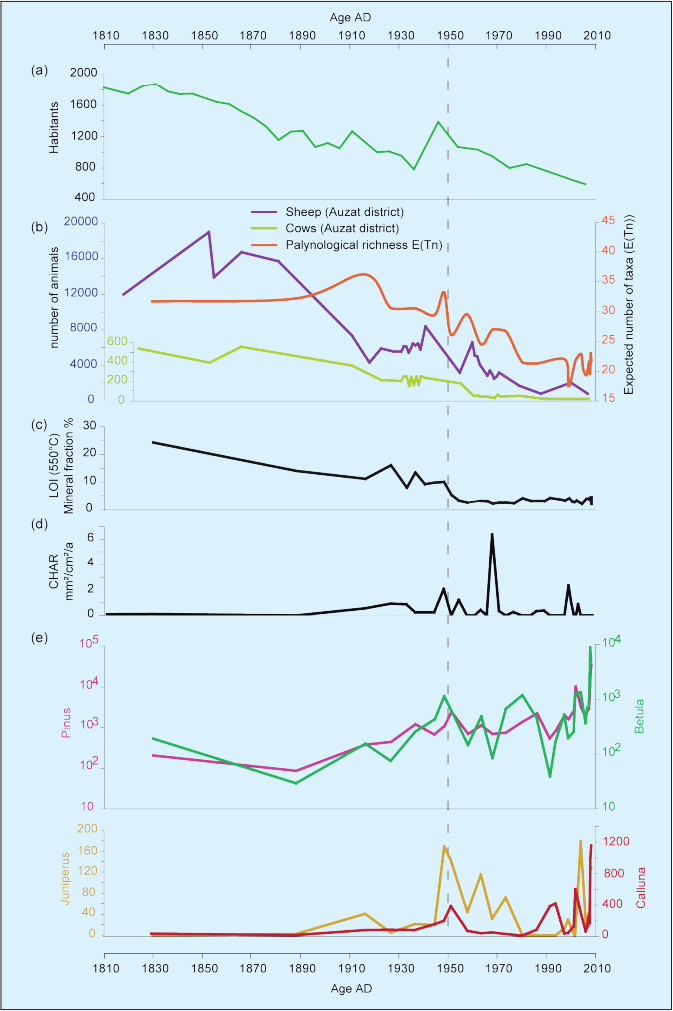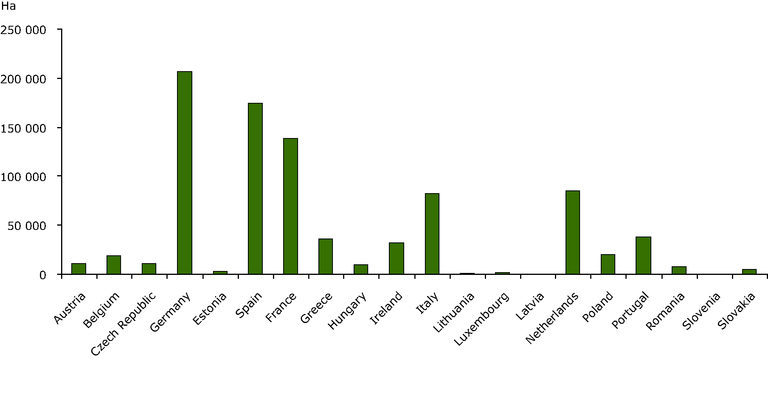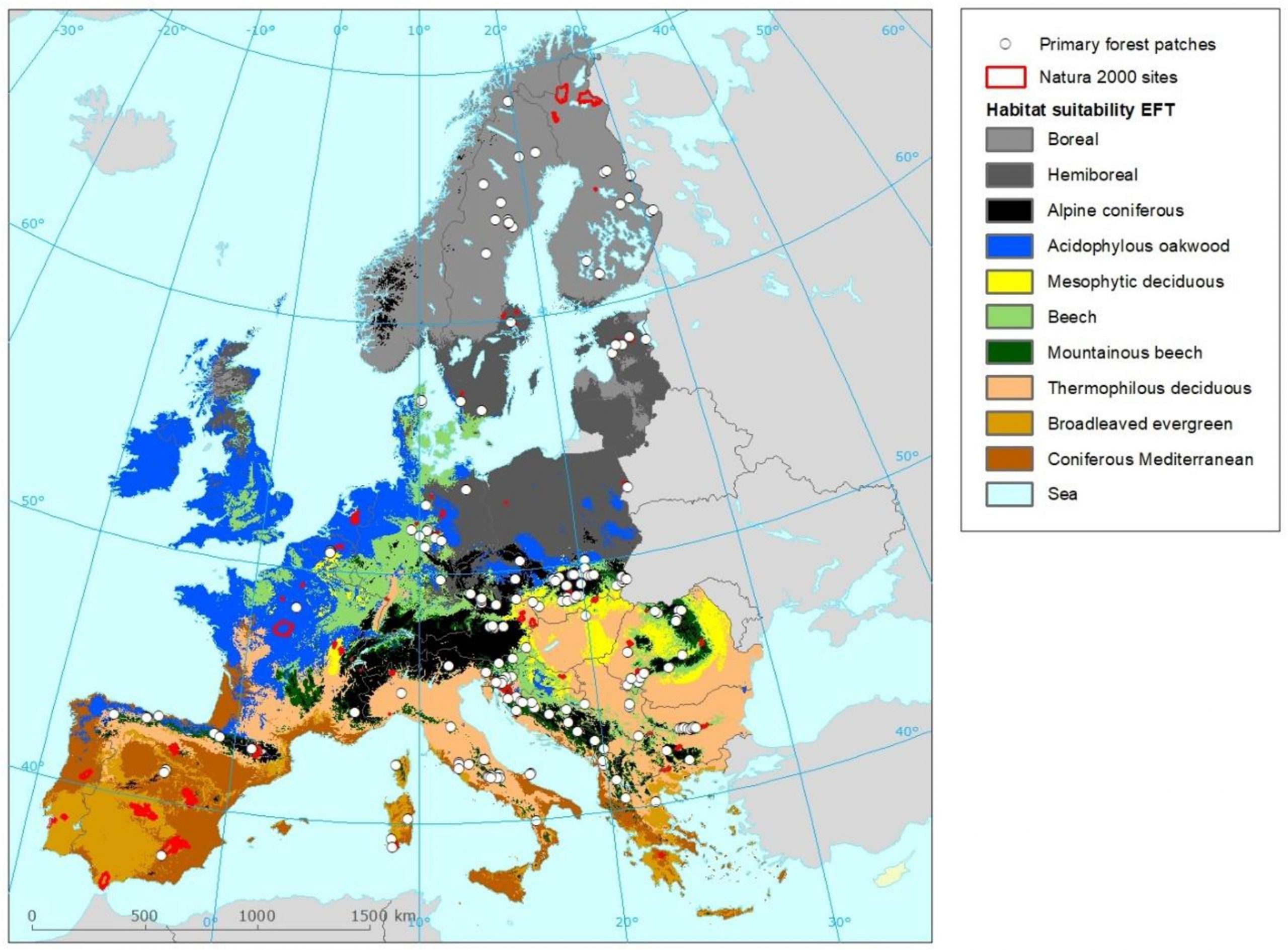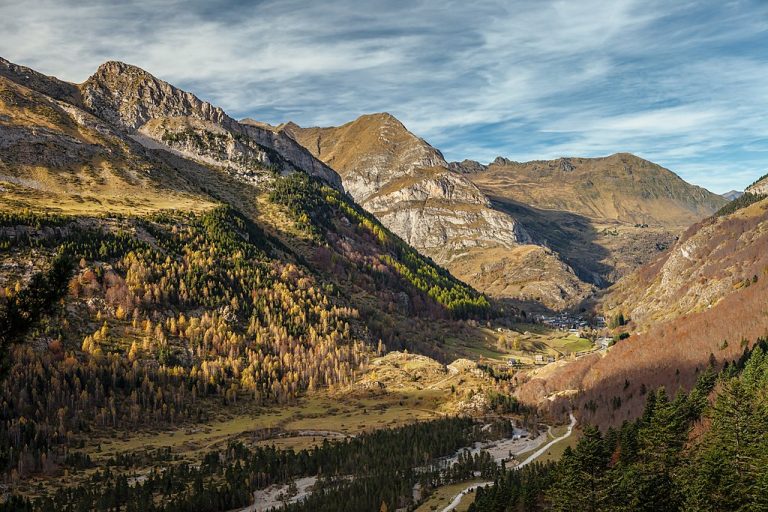France is often known for its beautiful cities that host a myriad of activities. While urban hotspots like Paris bring a wealth of tourists and business to packed city centers, the hidden beauty of the country lies within the rolling grasslands and diverse upland parks. Such parks, like the Pyrenees National Park, are home to a rich population of birds, plants, and animals, like the infamous Pyrenees Brown Bear. The park lies along the southern border of France and Spain, within the Pyrenees Mountains, and has established itself as not only a diverse home for many species but also as a tourist location. While the French wilderness and its many parks may hold a beauty only the most experienced tourist or visitor may find, the local population surrounding the park has been tapping into this natural wellspring for centuries. Utilizing the dense grasslands around the area, farmers began raising livestock for domestic use. As more farmers flocked towards this agricultural practice, the communities formed an identity around it. Today, many farmers continue to uphold the practices and identity of past generations as to not let their hard work be for nothing. However, following the rural exodus of the 1950s and the modernization of farming techniques, issues about forest regeneration and the reintroduction of the Pyrenees Brown Bear now threaten the population’s rich culture of livestock farming.
Rural communities across France would mostly utilize grasslands and moorlands for livestock grazing and agriculture. As an identity began to form around the practice, farmers across the country started using their livestock to shape the land they lived on.1 In the early 20th century, these farmers were criticized for their open grazing practices which were viewed as disgraceful towards natural systems and an improper way to treat the wilderness.2 Despite this, the grasslands formed through livestock grazing provide necessary ecosystem services, such as high-quality forage for livestock and suitable farmland for domestic use. While the practice was seen as disgraceful, the services provided are ideal for sustainable development and human quality of life.3 In mountainous environments, like the one around the Pyrenees National Park, livestock grazing has helped both sustain local communities and allowed for their deep-rooted cultural identity to continue to thrive within the livelihoods of current farmers. Along these mountainsides, farmers raise goats, cattle, and sheep to supply meat for domestic use.4 For the most part, grasslands provide the food necessary for the animals to eat and grow, reducing the need for crops, like corn, for grazing. Towards the mid-20th century, a decline in livestock and agricultural practices caused by rural depopulation led to spontaneous forest growth, with dense forests and shrublands taking over the once-populated open grazing pastures.5 This forest densification caused a shift in views from the locals who now perceived forest regeneration as more threatening towards their deep cultural ties, instead of grasslands. Because of this sudden depopulation, many villages lost farmers, and land abandonment become a big issue. With rural villages now facing a crisis of fewer farmers and abandoned land, communities shifted from agro-pastoral activities, activities focusing on both raising livestock and crop growth, to ones primarily focused on raising livestock. An example of this change in land use can be seen in the commune of Villelongue.
Villelongue is a small rural commune that sits 20km south of Lourdes and roughly 10km north of the Pyrenees National Park. Ideal climate and weather coupled with rich, fertile soil make the area within and around the commune perfect for growing crops. Leading up to 1950, meadows made up a large part of the land coverage, with about 70% of agricultural land use set aside for meadows.6 At the time, livestock pastures made up a small percentage of land use, with around 5%-7% of agricultural land being set aside for livestock grazing. Towards the 1970s, following the events of rural depopulation, land use shifted. As farmers left their countryside vistas in pursuit of dreams within urban cities, meadows were cut away in exchange for pastureland and existing cropland was converted into meadows to feed livestock. The population of farmers before 1950 was around 52 people. Following the rural depopulation, 8 farmers remained, meaning 84.6% of farmers left the village.7 While most of the abandoned land that resulted from this exodus of farmers has yet to be reutilized, a large portion of it has been covered by trees and shrubs, showing signs of forest regeneration over once-used agricultural land. The reintroduction of forests over abandoned land is seen as a threat towards cultural ideals and identity and is heavily despised by locals of the area. Now, after forest regeneration has further taken its toll on the village, environmentalists seek to question how this spontaneous regrowth affects the biodiversity of the area, and evaluate local opinions. Where most other opinions are in favor of regeneration, as it increases biodiversity and promotes the re-wilding of nature, locals both in the village and around the park actively oppose the thought of land returning to an unused condition. In response, they began arguing against the current conservation paradigm and questioning whether public money should be spent to maintain open landscapes.8

Another threat to the cultural identities of farming communities is urbanization. Urbanization is the growth of a population in a concentrated area. Part of urbanization is the movement of people from rural areas to growing cities. This, once again, links back to the rural exodus of the 1950s, with farmers leaving their rural villages to live in larger cities. In 2010, the European Environment Agency measured a 970,000-hectare loss in agricultural land due to urbanization between 1990 and 2000. Using the classic American conversion unit, the football field, 1 hectare is roughly 2.47 football fields, meaning 2,395,900 football fields of agricultural land were lost due to urbanization. Figure 2 shows that about 150,000 hectares of agricultural land were lost due to urbanization in France alone. This means that 370,500 football fields of agricultural land in France were lost between 1990 and 2000: 15.4% of the total agricultural land lost in Europe was only in France.11 Another part of this urbanization was the paving of wider roads through villages to introduce tractors and other farming machinery. The reason for this introduction is the advancement of technology making it easier to accomplish agricultural tasks and the increased demand of the market requiring quicker completion.12 Villelongue experienced this change as well. As modern machinery was introduced to the village, traditional agricultural practices began to be abandoned and replaced by more modern techniques. So, on top of forest regeneration and rural depopulation threatening cultural ties, rural communities now fight against both the advancement of technology and changing market demands.

After observing these three problems within the Pyrenees National Park and its surrounding wilds, it’s clear the farmers are facing a wide variety of issues that threaten their cultural roots. So what is the driving force behind these issues? In short, the answer is biodiversity. The reintroduction of the Pyrenees Brown Bear was designed to promote both the maintenance of biodiversity and the reintroduction of native species. While it seems easy on paper, with how little wilderness is left in the Pyrenees and Europe, the process is not so straightforward.20 In the case of the Pyrenees, the three issues described are all interconnected. After the effects of urbanization and rural depopulation took their toll on the local grazing communities, forests began to fill in the spots of abandoned pastureland. This not only increased the forest biodiversity of the area but also created more wilderness for animals to live in.21 22 So, with the regrowth of trees recreating the previously lost wilderness, the Pyrenese Brown Bear was able to return to the area. The reintroduced wilderness, like trees and shrubs, allows for the large predator to roam, hunt, and repopulate without coming into human contact all too often.23. Additionally, Figure 3 shows that the area of the park is considered a perfect spot for biodiversification. Alpine coniferous forests are considered to be species-poor forest types, meaning the number of species per unit of area is low.24 Coniferous forests are already of low biodiversity compared to other forest types, partly due to their poor soil content and winter weather conditions, and are the target of deforestation as well. Coniferous forests also grow slowly, so the effects of deforestation impact those forests much harder than others.25 As a result, efforts are being made to both preserve coniferous forests and increase their biodiversity, making way for reintroduction movements to occur.

So, the problem faced by the farmers of whether to allow forest regeneration to continue or hope to revive old cultural ties still plagues the upland farms. How long the issue will persist is dependent on the local communities. They must either change their cultural views and conform to policy standards set by the government or continue to fight against conservationists who wish to see the biodiversification of the area improve. With either approach, it is clear that the farmers’ struggle will continue.
- Jean Beudou, Guillaume Martin, and Julie Ryschawy, “Cultural and Territorial Vitality Services Play a Key Role in Livestock Agroecological Transition in France,” Agronomy for Sustainable Development 37, no. 4 (August 8, 2017): 36. ↵
- Cécile Barnaud et al., “Is Forest Regeneration Good for Biodiversity? Exploring the Social Dimensions of an Apparently Ecological Debate,” Environmental Science & Policy 120 (June 1, 2021): 66. ↵
- Maite Gartzia et al., “Physiognomic and Physiologic Changes in Mountain Grasslands in Response to Environmental and Anthropogenic Factors,” Applied Geography 66 (January 1, 2016): 2. ↵
- Anne Mottet et al., “Agricultural Land-Use Change and Its Drivers in Mountain Landscapes: A Case Study in the Pyrenees,” Agriculture, Ecosystems & Environment 114, no. 2 (June 1, 2006): 298. ↵
- Cécile Barnaud et al., “Is Forest Regeneration Good for Biodiversity? Exploring the Social Dimensions of an Apparently Ecological Debate,” Environmental Science & Policy 120 (June 1, 2021): 66. ↵
- Anne Mottet et al., “Agricultural Land-Use Change and Its Drivers in Mountain Landscapes: A Case Study in the Pyrenees,” Agriculture, Ecosystems & Environment 114, no. 2 (June 1, 2006): 301. ↵
- Anne Mottet et al., “Agricultural Land-Use Change and Its Drivers in Mountain Landscapes: A Case Study in the Pyrenees,” Agriculture, Ecosystems & Environment 114, no. 2 (June 1, 2006): 299. ↵
- Cécile Barnaud et al., “Is Forest Regeneration Good for Biodiversity? Exploring the Social Dimensions of an Apparently Ecological Debate,” Environmental Science & Policy 120 (June 1, 2021): 66. ↵
- Didier Galop et al., “Grazing Activities and Biodiversity History in the Pyrenees: New Insights on High Altitude Ecosystems in the Framework of a Human-Environment Observatory,” PAGES News 19, no. 2 (July 2011): 54. ↵
- Didier Galop et al., “Grazing Activities and Biodiversity History in the Pyrenees: New Insights on High Altitude Ecosystems in the Framework of a Human-Environment Observatory,” PAGES News 19, no. 2 (July 2011): 54-55. ↵
- Arwyn Jones, “Soil — SOER 2010 Thematic Assessment — European Environment Agency,” Publication (European Environment Agency, November 25, 2010): 15. ↵
- Anne Mottet et al., “Agricultural Land-Use Change and Its Drivers in Mountain Landscapes: A Case Study in the Pyrenees,” Agriculture, Ecosystems & Environment 114, no. 2 (June 1, 2006): 306. ↵
- Arwyn Jones, “Soil — SOER 2010 Thematic Assessment — European Environment Agency,” Publication (European Environment Agency, November 25, 2010): 14-15. ↵
- Nick Kettles, “Bestia Non Grata?,” The Ecologist (Bideford, United Kingdom: Resurgence Trust, March 2008). ↵
- Guillaume Chapron et al., “Which Future for the French Pyrenean Brown Bear (Ursus Arctos) Population? An Approach Using Stage-Structured Deterministic and Stochastic Models,” Comptes Rendus Biologies 326 (August 1, 2003): 175. ↵
- Susan Milius, “Wild Hair,” Science News (Washington, United States: Society for Science & the Public, April 20, 2002). ↵
- Nick Kettles, “Bestia Non Grata?,” The Ecologist (Bideford, United Kingdom: Resurgence Trust, March 2008). 1 ↵
- Jim Renne, “Yellowstone Park Wolves,” Yellowstone National Park, 1999. ↵
- Nick Kettles, “Bestia Non Grata?,” The Ecologist (Bideford, United Kingdom: Resurgence Trust, March 2008). 2 ↵
- Nick Kettles, “Bestia Non Grata?,” The Ecologist (Bideford, United Kingdom: Resurgence Trust, March 2008). 3 ↵
- Cécile Barnaud et al., “Is Forest Regeneration Good for Biodiversity? Exploring the Social Dimensions of an Apparently Ecological Debate,” Environmental Science & Policy 120 (June 1, 2021): 67, 69-70. ↵
- Maite Gartzia et al., “Physiognomic and Physiologic Changes in Mountain Grasslands in Response to Environmental and Anthropogenic Factors,” Applied Geography 66 (January 1, 2016): 1–2. ↵
- Nick Kettles, “Bestia Non Grata?,” The Ecologist (Bideford, United Kingdom: Resurgence Trust, March 2008). 3 ↵
- A. Barbati et al., “European Forest Types and Forest Europe SFM Indicators: Tools for Monitoring Progress on Forest Biodiversity Conservation,” Forest Ecology and Management, Mechanisms and predictors of ecological change in managed forests: A selection of papers from the second international conference on biodiversity in forest ecosystems and landscapes, 321 (June 1, 2014): 151. ↵
- Carl A. Roland, Sarah E. Stehn, and Joshua H. Schmidt, “Species Richness of Multiple Functional Groups Peaks in Alpine Tundra in Subarctic Alaska,” Ecosphere 8, no. 6 (2017): 1-3. ↵
- Ana Isabel Marín et al., “Mapping Forest Condition in Europe: Methodological Developments in Support to Forest Biodiversity Assessments,” Ecological Indicators 128 (September 1, 2021) 5. ↵
- European Commission, “The Common Agricultural Policy at a Glance,” Text, European Commission – European Commission. ↵



3 comments
Christian Guerrero
This was an interesting article as being a science major I never thought about issues of forest regeneration as people are always concerned with deforestation and endangering species and such but we never thought the issues we would have if it were the opposite. I really liked the graphs as it gave more meaning to the information and I can truly see with any environmental decision, we need to fined a balance to satisfy our needs along with the needs of nature in order to thrive and continue to live which any conflicts of both sides.
Camryn Blackmon
I didn’t realize there was an issue with environmentalism and the practice of small farmers. I also had not heard of forest regeneration before, but, interestingly, it is an issue for the farmers. The article also presented other significant factors to the issue, such as urbanization and the repopulation of endangered species.
Martha Nava
This is a very interesting article and topic. I have never heard of this issue before, and yet there is still no clear idea on which side to choose, the forest regeneration or to continue with their cultural ties. It is shocking to see that more than 80% of the farmers left the village. It is fascinating to see how these changes in their society could have such great environmental impacts.